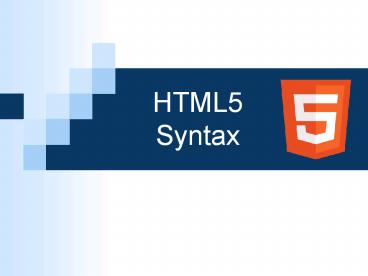HTML5 Syntax - PowerPoint PPT Presentation
Title: HTML5 Syntax
1
HTML5Syntax
2
Looser Syntax Rules
- In an effort to make HTML5 accommodate older web
pages, numerous things that would be invalid in
XHTML are now permitted as valid. - To web designers accustomed to writing strict
code in XHTML, these looser rules might appear
sloppy or unprofessional. - These relaxed rules are not suggestions or
guidelines for modern web programmers. Rather,
they were put in place to be more accepting of
older websites.
Though we will cover the new, looser syntax
rules, we will be adopting just a few of them for
this course. We will avoid the rest in favor of
cleaner and more readable syntax, very close to
what we learned in XHTML.
3
Capitalization
In XHTML, all elements and attributes are
required to be in lower case
ltbodygt ltp class"intro"gtThis is the first
paragraphlt/pgt lt/bodygt
While the following code will not validate as
error-free in XHTML, it is now considered valid
in HTML5
ltBODYgt ltp Class"intro"gtThis is the first
paragraphlt/Pgt lt/bodygt
Inconsistent capitalization makes reading code
more difficult and serves no useful purpose. For
these reasons, we will continue to use all
lower-case in our pages.
4
Closing Tags
In XHTML, elements such as ltpgt and ltligt require
closing tags
ltpgtThis is the first paragraph.lt/pgt ltpgtThis is
the second paragraph.lt/pgt ltulgt ltligtFirst list
itemlt/ligt ltligtSecond list itemlt/ligt lt/ulgt
But in HTML5, the following is considered valid
ltpgtThis is the first paragraph. ltpgtThis is the
second paragraph.lt/pgt ltulgt ltligtFirst list item
ltligtSecond list item lt/ulgt
Omitting closing tags makes reading code more
difficult and can lead to unexpected problems
when going back to edit pages. We will continue
to close all such elements.
5
Self-Closing Elements
In XHTML, self-closing elements require closing
slashes
ltbr /gt ltimg src"image1.jpg" alt"Description"
/gt lthr /gt
In HTML5, these closing slashed can now be
omitted
ltbrgt ltimg src"image1.jpg" alt"Description"gt lthrgt
These closing slashes were required by XHTML but
served no useful purpose and did not improve the
readability of code. For these reasons, we will
adopt this relaxed rule and omit them in all our
new HTML5 documents.
Other self-closing elements include ltmetagt and
ltlinkgt.
6
Attribute Quotes
In XHTML, all element attributes must be enclosed
in quotation marks
ltdiv id"header"gt ltimg src"image1.jpg"
alt"Description" /gt lta href"page2.html"gtClick
Herelt/agt
In HTML5, it's permissible to drop these quotes
ltdiv idheadergt ltimg srcimage1.jpg
altDescriptiongt lta hrefpage2.htmlgtClick Herelt/agt
Nearly all web programmers agree that omitting
attribute quotes is a bad idea. It reduces
readability of code and will result in major
errors if the attribute value contains special
characters or spaces. We will continue using the
quotes.
7
Form Attributes
In XHTML, in order to "pre-select" default
choices on forms, we used this syntax
ltinput type"radio" name"gender" value"male"
/gtMale ltinput type"radio" name"gender"
value"female" checked"checked" /gtFemale
In HTML5, we can shorten this a bit
ltinput type"radio" name"gender"
value"male"gtMale ltinput type"radio"
name"gender" value"female" checkedgtFemale
Like omitting self-closing tags, this change does
not affect readability and also saves us a little
typing, so we'll use the shorter syntax.
8
Optional Page Elements
By now, we have become accustomed to seeing three
basic elements in everyHTML page the lthtmlgt,
ltheadgt, and ltbodygt elements.
- lt!DOCTYPE htmlgt
- lthtml lang"en"gt
- ltheadgt
- ltmeta charset"utf-8"gt
- lttitlegtMy First HTML5 Pagelt/titlegt
- ltlink rel"stylesheet" href"style.css"gt
- lt/headgt
- ltbodygt
- ltpgtHTML5 is fun!lt/pgt
- lt/bodygt
- lt/htmlgt
9
Optional Page Elements Omitted
HTML5 now makes these three elements optional
- lt!DOCTYPE htmlgt
- ltmeta charset"utf-8"gt
- lttitlegtMy First HTML5 Pagelt/titlegt
- ltlink rel"stylesheet" href"style.css"gt
- ltpgtHTML5 is fun!lt/pgt
Hard to believe, but this is a completely valid
web document in HTML5!
Very few web programmers choose to omit these
traditional elements, which logically organize
the document and make it easier to understand the
flow of the page content, especially when
reviewed by others. We will continue to include
them in every document we create.
10
HTML5 Page Validation
- Just as we did with XHTML, we can submit our
pages to the validator athttp//validator.w3.org/
- Let's try it now with the basic page that omits
the lthtmlgt, ltheadgt, and ltbodygttags
11
Validation Results
Even with the relaxed rules, running pages
through the validator can be helpful to catch
typos, missing tags, improperly nested elements,
and other common errors.































